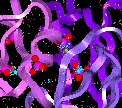 Empirical Fit of the
Surface
Empirical Fit of the
Surface
Contents
Solving Eq. 2-3 is important if you
are interested in the structure or time evolution of a molecule. As
written, Eq. 2-3 is the Schrödinger equation for the motion of
the nuclei on the potential energy surface. In principle, Eq. 2-2 could be solved for the
potential energy E, and then Eq. 2-3 could be solved. However, the
effort required to solve Eq. 2-2 is extremely large, so usually an
empirical fit to the potential energy surface is used. In any case,
the solution of the quantum mechanical form of Eq. 2-3 is called
quantum dynamics, but since the nuclei are relatively heavy
objects, the quantum mechanical effects are often insignificant, in
which case Eq. 2-3 can be replaced by Newton's equation of motion:
- Eq. 2-4:
-

The solution of Eq. 2-4 using an empirical fit to
the potential energy surface E(R) is called molecular
dynamics. Molecular mechanics ignores the time evolution of the
system and instead focuses on finding particular geometries and their
associated energies or other static properties. This includes finding
equilibrium structures, transition states, relative energies, and
harmonic vibrational frequencies.
The empirical fit to the potential energy surface is the
forcefield. The forcefield defines the coordinates used, the
mathematical form of the equations involving the coordinates, and the
parameters adjusted in the empirical fit of the potential energy
surface. The forcefields commonly used for describing molecules employ
a combination of internal coordinates (bond distances, bond angles,
and torsions) to describe the bond part of the potential energy
surface, and interatomic distances to describe the van der Waals and
electrostatic interactions between atoms. The functional forms range
from simple quadratic forms to Morse functions, Fourier expansions,
Lennard-Jones potentials, etc. The goal of a forcefield is to describe
entire classes of molecules with reasonable accuracy. In a sense, the
forcefield interpolates and extrapolates from the empirical data of
the small set of molecules used to parameterize the forcefield to a
larger set of related molecules and structures.
The physical significance of most of the types of interactions in a
classical forcefield is easily understood. Describing a molecule's
internal degrees of freedom in terms of bonds, angles, and torsions is
natural. The analogy of vibrating balls connected by springs to
describe molecular motion is equally familiar. However, it must be
remembered that such classical models have limitations. Consider for
example the difference between a classical and a quantum mechanical
``bond''.
Covalent bonds can, to a first approximation, be described by a
harmonic oscillator, both in quantum and classical theory. Consider
the classic harmonic oscillator in the left panel of Figure 2-1. A ball poised at the
intersection of the pale grey horizontal line with the parabolic
energy surface (thick magenta line) would begin to roll away,
converting its potential energy to kinetic energy and achieving a
maximum velocity as it passes the minimum. Its velocity (kinetic
energy) is then converted back into potential energy until, at the
exact same height as it had started, it would pause momentarily before
rolling back. The interconversion of kinetic and potential energy in
such a classical system is familiar and intuitive. The probability
that the ball is at any point along its trajectory is inversely
proportional to its velocity at that point. This probability is
plotted above the parabolic curve (thin blue line). The probability is
greatest near the high-energy limits of its trajectory (where it is
moving slowly) and lowest at the energy minimum (where it is moving
quickly). Because the total energy cannot exceed the initial potential
energy defined by the starting point, the probability drops to zero
outside the limit defined by the intersection of the total energy
(pale grey horizontal line) with the parabola.
Describing a quantum mechanical ``trajectory'' is impossible, because
the uncertainty principle prevents an exact, simultaneous
specification of both position and momentum. However, the
probability that the quantum mechanical ball will be at a given
point on the parabola can be quantified. The quantum mechanical
probability function plotted in the right panel of Figure 2-1 is very different from
the classical system. First, the highest probability is at the energy
minimum, which is the opposite of the classical system. Second, the
quantum mechanical ball can actually be found beyond the classical
limits imposed by the total energy of the system (tunneling). Both
these properties can be attributed to the uncertainty principle.
With such a different qualitative picture of fundamental physical
principles, is it reasonable to use a classical approach for obviously
quantum mechanical entities like bonds? In practice, many experimental
properties such as vibrational frequencies, sublimation energies, and
crystal structures can be reproduced with a classical forcefield, not
because the systems behave classically, but because the forcefield is
fit to reproduce relevant observables and therefore includes most of
the quantum effects empirically. Nevertheless, it is important to
appreciate the fundamental limitations of a classical approach.
Applications beyond the capability of most classical methods
include:
- Electronic transitions (photon absorption).
- Electron transport phenomena.
- Bond breaking/formation.
- Proton transfer (acid/base reactions).
The actual coordinates of a molecule combined with the forcefield data
create the energy expression or target function for the
molecule. This energy expression is the equation that describes the
potential energy surface of a particular molecule as a function of its
atomic coordinates. As a simple example, consider the following
equation, which might be used to describe the potential energy surface
of a water molecule:
- Eq. 2-5:
-

where Koh,
boh0,
Khoh, and  hoh0 are
parameters of the forcefield, b is the current bond length of
one OH bond, b' is the length of the other OH bond, and
hoh0 are
parameters of the forcefield, b is the current bond length of
one OH bond, b' is the length of the other OH bond, and  is the HOH angle.
is the HOH angle.
In this example, the forcefield defines:
- The coordinates to be used (bond lengths and angles).
- The functional form (a simple quadratic in both types of
coordinates).
- The parameters (the force constants Koh
and Khoh, as well as the reference values
boh0 and
 hoh0).
hoh0).
Eq. 2-5 is an example for a simple case. Eq. 2-6
is a more realistic energy expression:
- Eq. 2-6:
-

The first four terms in this equation are sums that reflect the energy
needed to stretch bonds (b), bend angles ( ) away from their reference values, rotate
torsion angles (
) away from their reference values, rotate
torsion angles ( ) by twisting atoms about
the bond axis that determines the torsion angle, and distort planar
atoms out of the plane formed by the atoms they are bonded to (
) by twisting atoms about
the bond axis that determines the torsion angle, and distort planar
atoms out of the plane formed by the atoms they are bonded to ( ). The next five terms are cross terms that
account for interactions between the four types of internal
coordinates. The final term represents the nonbond interactions as a
sum of repulsive and attractive Lennard-Jones terms as well as
Coulombic terms, all of which are a function of the distance between
atom pairs rij. The forcefield defines the
functional form of each term in this equation as well as the
parameters such as Db,
). The next five terms are cross terms that
account for interactions between the four types of internal
coordinates. The final term represents the nonbond interactions as a
sum of repulsive and attractive Lennard-Jones terms as well as
Coulombic terms, all of which are a function of the distance between
atom pairs rij. The forcefield defines the
functional form of each term in this equation as well as the
parameters such as Db,  , and b0. The forcefield
also defines the internal coordinates such as b,
, and b0. The forcefield
also defines the internal coordinates such as b,  ,
,  , and
, and  as a function of the Cartesian atomic
coordinates, although this is not explicitly obvious in Eq. 2-6. Finally, the energy expression in Eq. 2-6
is cast in a general form. The true energy expression for a specific
molecule includes information about the coordinates that are included
in each sum. For example, it is common to exclude interactions between
bonded and 1-3 atoms in the summation representing the nonbond
interactions. Thus, a true energy expression might actually use a list
of allowed interactions rather than the full summation implied in Eq. 2-6.
as a function of the Cartesian atomic
coordinates, although this is not explicitly obvious in Eq. 2-6. Finally, the energy expression in Eq. 2-6
is cast in a general form. The true energy expression for a specific
molecule includes information about the coordinates that are included
in each sum. For example, it is common to exclude interactions between
bonded and 1-3 atoms in the summation representing the nonbond
interactions. Thus, a true energy expression might actually use a list
of allowed interactions rather than the full summation implied in Eq. 2-6.
 Main
access page
Main
access page  Theory/Methodology access.
Theory/Methodology access.
 Describe-System access
Describe-System access
 The Potential Energy Surface
The Potential Energy Surface
 Periodic Boundary Conditions
Periodic Boundary Conditions
Copyright Biosym/MSI
 Empirical Fit of the
Surface
Empirical Fit of the
Surface Empirical Fit of the
Surface
Empirical Fit of the
Surface Main
access page
Main
access page  Theory/Methodology access.
Theory/Methodology access.  Describe-System access
Describe-System access
 The Potential Energy Surface
The Potential Energy Surface
 Periodic Boundary Conditions
Periodic Boundary Conditions